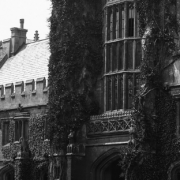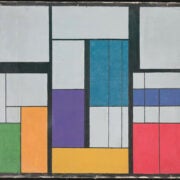Artstor & STEM: How art can enhance scientific and mathematical thinking

Joseph Wright of Derby, An Experiment on a Bird in the Air Pump, 1768. The National Gallery, London
By Katy Matsuzaki, Manager of Academic Programs, New Britain Museum of American Art
Recently a group of docents at the New Britain Museum of American Art gathered in a gallery filled with landscapes and portrait paintings to discuss how they might approach the art with a middle school math class scheduled for a visit. As they looked closely at works by Georgia O’Keefe and Robert Henri, and listened to the more math-minded among them explore geometry, proportion, and compositional formulas therein, fear of the “math tour” quickly gave way to excitement over a new, mathematical way to approach and appreciate artworks.
As the staff member who greenlighted the math field trip, I was heartened by the docents’ willingness to embrace the unknown. Math students in an art museum might at first seem like a foreign concept, but in reality, the immersive visual environment that a curated collection of art images provides can be an incredibly beneficial learning tool for not only the study of mathematics, but the other STEM fields (science, technology, math, and engineering) as well.
Young children naturally embrace the concept of STEAM – that is, incorporating art (and design) into the study and practice of STEM. On their own, early learners discover and make sense of the world through creative play and curious eyes; in instructional settings, they explore science and math through pictures and hands-on projects. Somewhere along the line, this intensely visual STEM education gives way to a much more textual and far less creative treatment of the subjects. And yet, each of the STEM disciplines is inherently visual – scientists, technologists, engineers and mathematicians alike communicate their work through graphs, charts, illustrations, visualizations, infographics, photographs, diagrams, and more – making a strong case for visual literacy training at every stage of STEM instruction, from preschool to pre-professional programs.
Visual literacy, as defined by the EDUCAUSE Learning Initiative, is “the ability to recognize and critically appreciate meaning in visual content and to use visual elements to create effective communication.” Put more simply, a visually literate individual “reads” images as one might process the words in a book, actively engaging with them to gain understanding and appreciate the content within. It is a critical 21st century skill, but as a recent Artstor Twitter chat revealed, the methods and contexts for teaching visual literacy in higher education settings can be varied, undefined, and even nonexistent. Bringing artworks into the classroom is an easy and accessible way to promote this skill while engaging learners in a new way to connect with course content.
- Georges Vantongerloo, Composition II, Indigo Violet Derived from Equilateral Triangle, 1921. Image and original data provided by The Museum of Modern Art, ©2008 Artists Rights Society (ARS), New York / Pro Litteris, Zurich
A number of simple visual literacy exercises can be employed in a museum gallery, or through the vast virtual museum that Artstor provides, in order to enhance STEM curricula through the close exploration of real art images. The first step in facilitating such training is to choose artworks that will complement disciplinary content by giving students a conceptual lens with which to approach them; working with course instructors, or even students themselves, to “curate” their own visual literacy training around broad course concepts and guiding questions can give much deeper meaning to exercises like a visual analysis, sketching from artworks, and analogizing with abstract art.
A visual analysis is an opportunity for students to have a prolonged encounter with a single work of art; it requires close and thorough looking, invites personal impressions and interpretations, and stimulates group discussion. It can last anywhere from 20 minutes to an hour or more, and asks participants to make sense of what they see in the art. As such, it parallels the practice of scientific observation, a thinking strategy employed by scientists to help them make sense of natural phenomena. As science columnist Annie Murphy Paul writes, scientific observation “is a rigorous activity that integrates what the scientists are seeing with what they already know and what they think might be true” – just as a good visual analysis does. Viewers, as scientists do, should form hypotheses (about subject matter, process, artistic intent, etc.) and back up their assertions with visible evidence drawn directly from the artwork. How, what, and why questions (How did the artist make this? What is going on in this picture? Why did the artist create it?) may be used to invite these hypotheses.
Sketching from artworks can be a way to deepen the visual analysis while further engaging the mind in the sort of purposeful looking that scientific observation requires. Just as a scientist might record his or her observations in pictorial form, so too can sketching artworks help students to clarify what they see, focus on important details, and grow comfortable with the idea of drawing to learn. In their article, “Drawing to Learn in Science,” Shaaron Ainsworth, Vaughan Prain, and Russell Tytler recognize that while science instruction tends to focus on interpreting others’ visualizations, the act of creating one’s own visual representations of science can both generate and demonstrate understanding. An initiative known as “Picturing to Learn” is proof of the benefits of drawing for science and engineering students, and I encourage you to check out the website of this innovative (though now concluded) program.

Georges Braque, Abstraction, 1920. Image and original data provided by The Phillips Collection, © 2009 Artists Rights Society (ARS), New York / ADAGP, Paris
Not sure how to get students comfortable with drawing? It’s important that they abandon the idea of making art, but rather, experiment to find their own unique style of mark-making that easily and quickly translates their thoughts into visual form. Artists do this when creating preliminary sketches, and many such sketches can be found in the Artstor Digital Library. Try having students copy artist sketches before drawing from finished works, or introduce them to such beginner-friendly techniques as sketchnoting and blind contour drawing. Engaging regularly in sketching activities, and with a variety of art objects and images, sharpens spatial thinking skills and allows students to build up their own visual vocabularies.
Like artist sketches, abstract art can be a good starting place for STEM audiences. Both math and science involve abstract thinking, and students without art backgrounds may be most comfortable working with artworks that are open to many possible interpretations. By pairing abstract images of their choice with STEM concepts, students can demonstrate their understanding of those concepts through analogizing. They might, for example, select an artwork that resonates for them with a topic or issue covered in class and then incorporate it into a written assignment – as if choosing a cover image for a scientific journal. Explaining their choice of imagery via class presentation (much as the art director of Science did here) can solidify learning and develop valuable skills of peer-to-peer communication.
With a minimal investment of time, incorporating artworks into STEM curricula can empower students to more confidently create, consume, critique, and communicate through visual content in both their studies and, eventually, their careers.

